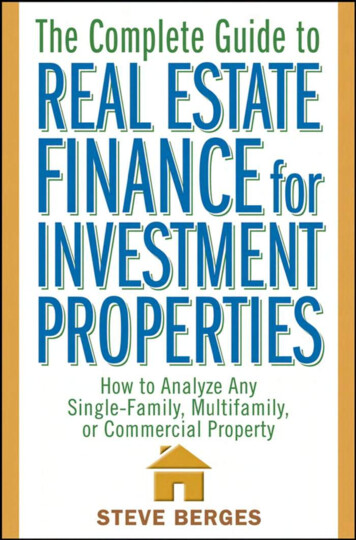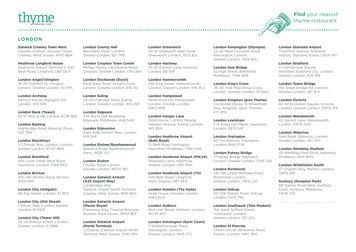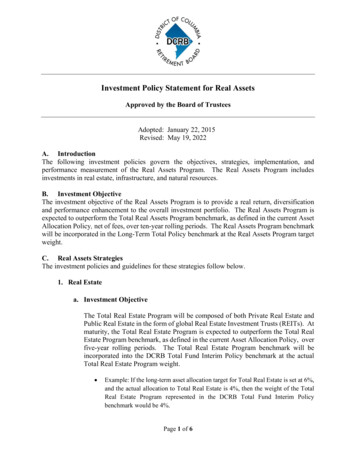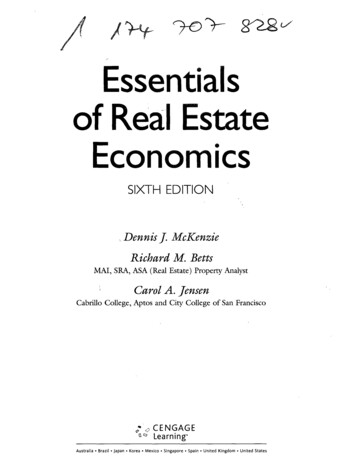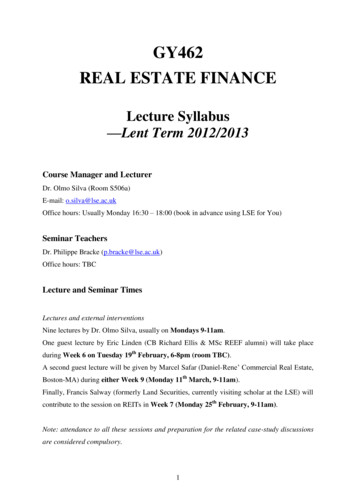
Transcription
GY462REAL ESTATE FINANCELecture Syllabus—Lent Term 2012/2013Course Manager and LecturerDr. Olmo Silva (Room S506a)E-mail: o.silva@lse.ac.ukOffice hours: Usually Monday 16:30 – 18:00 (book in advance using LSE for You)Seminar TeachersDr. Philippe Bracke (p.bracke@lse.ac.uk)Office hours: TBCLecture and Seminar TimesLectures and external interventionsNine lectures by Dr. Olmo Silva, usually on Mondays 9-11am.One guest lecture by Eric Linden (CB Richard Ellis & MSc REEF alumni) will take placeduring Week 6 on Tuesday 19th February, 6-8pm (room TBC).A second guest lecture will be given by Marcel Safar (Daniel-Rene’ Commercial Real Estate,Boston-MA) during either Week 9 (Monday 11th March, 9-11am).Finally, Francis Salway (formerly Land Securities, currently visiting scholar at the LSE) willcontribute to the session on REITs in Week 7 (Monday 25th February, 9-11am).Note: attendance to all these sessions and preparation for the related case-study discussionsare considered compulsory.1
SeminarsStudents will be divided in four groups:-Group a: Thursday 14:00-16:00-Group b: Thursday 16:00-18:00-Group c: Friday09:00-11:00-Group d: Fridays12:00-14:00Seminars are held every two weeks and run in Weeks 2, 4, 6, 8 and 10. Mr. Philippe Brackewill teach the seminars. Check on LSE for You the group you have been assigned to.Teaching MethodThe GY462 course consists of 9 x 2 hour lectures, 2 x 2 hour guest lectures and 5 x 2 hourseminars. The lectures are intended to convey a conceptual understanding and analyticalcompetence in the evaluation of real estate investment and financing decisions. The guestlectures are meant to complement the material presented during the lectures with insightsfrom the real estate practice. Finally, the seminars will focus on helping you solve thehomework assignments and prepare for the exams.Teaching MaterialLecture notes are typically available prior to the lecture and can be downloaded/accessedusing the GY462 Moodle page.AssessmentThe assessment is by means of a formal two hour written examination in the Summer Term.The exam paper will contain four questions. Candidates should attempt two questions.Course Objectives and RequirementsThe course aims to provide students with concepts and techniques for analyzing financialdecisions in real estate development and investment. Topics include: Basic real estateinvestment analysis; financial leverage; fixed rate mortgage loans and more flexible mortgagearrangements; mortgage payment issues; debt securitization; REITs; real options; andinternational aspects of real estate finance. The course is intended (and compulsory) forstudents of the MSc Real Estate Economics and Finance. The course is optional for studentsof the MSc Accounting and Finance and MSc Management and Regulation of Risk. Thecourse is available for other students with suitable qualification in finance (subject to Dr.2
Silva’s and the respective programme director’s approval). It is assumed that students alreadyhave a good knowledge of asset market theory. A basic financial calculator (e.g., a TexasInstruments BA 2 Plus) is required for both seminars and exams. You are responsible forknowing how to compute annuities, present values, etc. with your calculator.3
Syllabus—Lent Term 2012/2013 (Provisional)GY462—Real Estate FinanceLECTURE (Dr. Olmo Silva)Introduction and OverviewIIIREAL ESTATE INVESTMENT ANALYSIS AND FINANCIAL LEVERAGEPart 1:Investment Analysis- Valuation of income producing properties, including: discounted cashflow methods; shortcut methods; choice of discount rate- Pro-forma- Investment decision- Risk assessment- Land valuation, including: traditional approach; real option approachPart 2:Financial Leverage- Leverage and returns- Leverage and yield/growth- Leverage and risk- Other reasons to borrow or not to borrowMORTGAGE BASICS & ANALYSISPart 1:Fixed rate mortgage loans- Basic formula- Applications- Effective cost of borrowingPart 2:Mortgage payment issues- Inflation- Reducing monthly payments (GPMs, ARMs, SAMs)Part 3:More flexible mortgage arrangements (time permitting)- Participation loans- Convertible mortgages- Sale-leaseback of the landCase Study I:Analysis of a Property: Investing and Leveraging (Eric Linden, CB RichardEllis)Case Study II: Analysis of a Property: Redeveloping and Managing (Marcel Safar, DanielRene’ Commercial Real Estate, Boston-MA)4
III REAL ESTATE CAPITAL MARKETS AND SECURITIESPart 1:Real Estate Investment Trusts (REITs)- REITs and UPREITs- REIT valuationPart 3:Debt securitization- The evolution of the Secondary Mortgage Market- Residential Mortgage Backed Securities (RMBS); including: risks andrisk allocation; main types of RMBS; pricing issues and prepayment rates- Commercial Mortgage Backed Securities (CMBS), including:characteristics of CMBS; comparison with RMBS; and structuring aCMBS deal (tranching)Part 3:Subprime Mortgages and the Dynamics of the Crisis- Sub-prime mortgages and sub-prime mortgage-backed securities. Whatare they? And how do they differ?- The 2007 crisis: facts and explanations. What happened and why?- Implications for RE financial markets and RE real activities- Complexity and incentives: policy interventions and the debate on therole of regulation in financeIV INTERNATIONALISATION OF REAL ESTATE MARKETS (time permitting)Part 1:Some stylized facts: Scope for international diversification?Part 2:International trends: Is there a trend towards a global RE cycle?GY462—Real Estate FinanceSEMINAR (Dr. Philippe Bracke)1Problem Set 1—Real Estate Investment Analysis2Problem Set 2—Pro-Forma & Financial Leverage3Problem Set 3— Mortgage Analysis4Problem Set 4—Case Study5Problem Set 5—Real Estate Market Securitization5
Reading List (Provisional)The reading list below is provisional. A revised version of this reading list may be handed outduring the term. All listed readings are available either at the library or on-line or on theMoodle course page.IMain Text BookThere are two main textbooks that will be used throughout the term:[1] BRUEGGEMAN, W. B.ANDJ. D. FISHER, Real Estate Finance & Investments (12thEdition or more recent), McGraw-Hill International, New York (N.Y.).The book is usually available at LSE’s Waterstone bookstore. The order lag is usually two tothree working days. The book can also be borrowed from the LSE library. Since nearly allchapters are compulsory reading, it makes a worthwhile buy.[2] LINNEMAN, P, 2004, Real Estate Finance & Investments: Risks and Opportunities, 2ndedition (or more recent).This book is self-published by the author (who is a well-known academic as well as asuccessful practitioner in the real estate industry) and can be ordered via www.linnemanassociates.com/textbook.html. The book is also available at the LSE library. Thebook omits certain topics that are relevant for the lectures. However, it provides excellentinsights into the key concepts of real estate finance and investment strategy (from atheoretical as well as practical point of view). This second reference is also worth buying.6
II Other Recommended Real Estate Economics and Finance Textbooks[3] GELTNER, D.ANDN. G. MILLER, 2001, Commercial Real Estate Analysis andInvestments (1st Edition or more recent), Mason, OH: South Western.[4] BALL M., C. LIZIERIANDB. MACGREGOR, 1998, The Economics of CommercialProperty Markets, Routledge.[5] BROWN G. R. AND G. A. MATYSIAK, 2000, Real Estate Investment. A Capital MarketApproach, Essex, UK: FT Prentice Hall.IIIProvisional Reading List by Lecture(Note: the chapters listed below follow Brueggeman & Fisher, 12th edition and Linneman 2ndedition. More recent versions of the books contain similar material, though chapter numberingmight be different)Lecture 1 — Real Estate Investment Analysis I(Introduction and Overview—Investment Analysis)Compulsory Readings[1] BRUEGGEMAN & FISHER, Chapters 3, 9 & 10 (intro chapters, valuation)[2] LINNEMAN, Chapters 1-3 (intro chapters)Other Recommended Readings[1] BRUEGGEMAN & FISHER, Chapters 1 (legal concepts)Lecture 2 — Real Estate Investment Analysis II(Investment Analysis—Basics)Compulsory Readings[1] BRUEGGEMAN & FISHER, Chapters 10, 11 & 13 (investment and risk analysis)[2] LINNEMAN, Chapters 6-8 (due diligence, cap rates, pro-forma)7
Lecture 3 — RE Investment Analysis III & Financial Leverage(Land Valuation—Real Options—Financial Leverage)Compulsory Readings[1] BRUEGGEMAN & FISHER, Chapters 12 & 13 (financial leverage, real options)[2] LINNEMAN, Chapter 12 (financial leverage)Lecture 4 — Mortgage Basics & Analysis I(Fixed Rate Mortgage Loans—Mortgage Payment Issues)Compulsory Readings[1] BRUEGGEMAN & FISHER, Chapters 2, 4 & 6 (fixed rate, residential)Lecture 5 — Mortgage Basics & Analysis II(Mortgage Payment Issues, Cont. —More Flexible Mortgage Arrangements)Compulsory Readings[1] BRUEGGEMAN & FISHER, Chapters 5 & 12 (flexible arrangements, alternatives)Other Recommended Readings[1] BRUEGGEMAN & FISHER, Chapter 8 (financing residential properties)CASE STUDY I – Analysis of a Property: Investing and Leveraging (E. Linden, CBRE)CASE STUDY II – Analysis of a Property: Redeveloping and Managing (M. Safar,Daniel Rene’ Commercial Real Estate, Boston-MA)8
Lecture 6 — Real Estate Capital Markets and Securities I(Real Estate Investment Trusts)Compulsory Readings[1] BRUEGGEMAN & FISHER, Chapter 21 (REITs)[2] LINNEMAN, Chapter 18 (REITs)Other Recommended Readings[1] LINNEMAN, Chapter 17 (RE Private Equity Funds as alternative to REITs)Lecture 7 — Real Estate Capital Markets and Securities II(Debt Securitization)Compulsory Readings[1] BRUEGGEMAN & FISHER, Chapters 19 & 20 (secondary market)[2] LINNEMAN, Chapter 14 (CMBS)[3] Frame, W. S. and L. J. White (2005): “Fussing and Fuming over Fannie and Freddie:How Much Smoke, How Much Fire?” Journal of Economic Perspectives 19(2), 159184.9
Lecture 8 — The Dynamics of the Subprime-Mortgage Crisis(provisional; to be updated as more research becomes available)[1] Buiter, W (2008): “Lessons From the North Atlantic Financial Crisis”, paper presentedat the conference on “The Role of Money Markets”, Columbia University and FederalReserve Bank of New York, My 2008.[2] Dell’Arriccia G., D. Igan and L. Laeven (2008): “Credit Booms and LendingStandards: Evidence From the Subprime Mortgage Markets”, CEPR Discussion Papern.6683.[3] Gorton, G. (2008): “The Panic of 2007”, NBER Working Paper number 14358.[4] Jaffee, D. J. Quigley (2011): “The Future of the Government Sponsored Entreprises:The Role of Government in the U.S. Mortgage Market”, paper prepared for the NBERConference on “Housing and the Financial Crisis”.[5] Keys, B., T. Mukherjee, A. Seru and V. Vig (2008): “Did Securitization Lead to LaxScreening? Evidence From Subprime Loans 2001-2006”, mimeo, London BusinessSchool.[6] Kiff, J. and P. Mills (2007): “Money for Nothing and Checks for Free: RecentDevelopments in US Subprime Mortgage Markets”, IMF WP/07/188.[7] Mian, A. and A. Sufi (2008): “The Consequences of Mortgage Credit Expansion:Evidence From the 2007 Mortgage Default Crisis”, mimeo, University of Chicago,Graduate Business School.Other Recommended Readings[1] Feldstein, M. (2007): “Housing, Credit Markets and The Business Cycle”, NBERWorking Paper number 13471.[2] Pagano, M. and P. Volpin (2010); “Credit Ratings Failures and Policy Options”,Economic Policy, April 2010.[3] Reinhart, C. and K. Rogoff (2008): “Is the 2007 US Sub-Prime Financial Crisis SoDifferent? An International Historical Comparison”, NBER Working Paper number13761.[4] Readings in the symposium on “Early Stages of the Credit Crunch” published in theJournal of Economic Perspectives, Vol. 23, Number 1, Winter 2009.[5] Readings in the symposium on NBER Housing Programme Conference, Cambridge,MA. Available at: http://www.nber.org/ confer/2011/HFC11/HFC11prg.html10
Lecture 9 — Internationalisation of Real Estate Markets (time permitting)(Scope for International Diversification—Trends in International Real Estate)Compulsory Readings[1] BRUEGGEMAN & FISHER, Chapter 22 (portfolio and performance considerations)[2] Sirmans, C.F. and E. Worzala (2003): “International Direct Real Estate Investment: AReview of the Literature”, Urban Studies 40(5/6), 1081-1114.[3] Worzala, E. and C.F. Sirmans (2003): “Investing in International Real Estate Stocks:A Review of the Literature”, Urban Studies 40(5/6), 1115-1149.11
Note on the Handouts The handouts are designed as ‘skeleton’ lecture notes. They provide the ‘bare bones’ ofthe lecture. They are the absolute essentials such as key points, precise definitions, ordifficult-to-draw graphs. Skeleton notes leave you to ‘flesh out’ the subject matter in yourown words. The handouts are intended to free you from excessive note-taking so that you can take amore active part in the session. They are intended to help you organize and reflect oncourse material. The handouts are by no means complete. Furthermore, reading lecture notes withoutattending the lecture can be misleading. The handouts do not dispense you from doingthese three things:1.Attend the lectures – Understanding lecture notes is much easier after the lecture2.Do the readings – Handouts can at best provide an overview and summary of aparticular topic. Readings help you reflect, question, and understand a particularsubject matter3.Reflect and think about the issues and the problems – This is the main objective ofthe handouts As we assess analytical skills and critical independent thinking, do not reproduce lecturenotes in exams, essays and dissertations. Reproducing lecture notes does not demonstrateyour ability to think and to use what you have learned intelligently. It just demonstratesthat you have a good memory. Finally, feedback on handouts/lecture notes is highly appreciated. Knowing what isunclear and could be improved helps me improving the effectiveness of my teaching andyour learning.12
1 Problem Set 1—Real Estate Investment Analysis 2 Problem Set 2—Pro-Forma & Financial Leverage 3 Problem Set 3— Mortgage Analysis 4 Problem Set 4—Case Study 5 Problem Set 5—Real Estate Market Securitization . 6 Reading List (Provisional) The reading list below is provisional. A revised version of this reading list may be handed out
